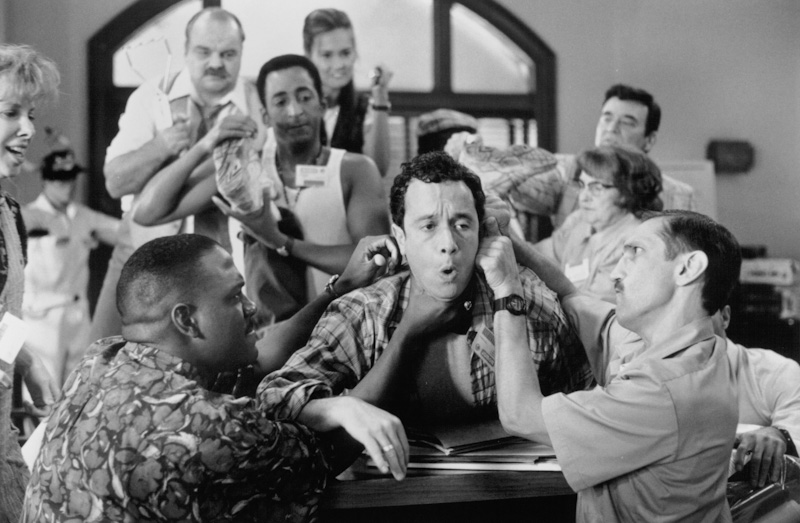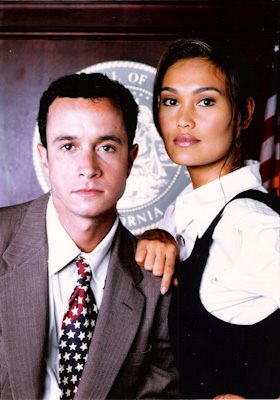The trials of 'Jury Duty' in life and in art

The cast of the 1995 comedy movie Jury Duty. Photo from MovieStillsDB.
My last entry focused on a new streaming series titled Jury Duty. If you haven’t given it a read, it’s worth a few minutes of your time. Obviously, I’m biased. Nevertheless, that installment discusses a show that has grown a bit of a cult following, and the premise is interesting if nothing else.
As I mentioned in the previous column, the series made me reminisce about one of my favorite comedies of the same name. Disclaimer: I’m an unabashed Pauly Shore fan. I still own my DVD copy of Bio-Dome, and some of my favorite memories from the early ’90s involve basking in the glory of Shore’s juvenile humor with my best friends.
As such, I’ve decided to revisit the film version of Jury Duty from the perspective of law and pop culture. I’m glad I did.
‘Jury Duty’ (the movie)
Within minutes of starting the movie, I was transported back nearly 30 years. If you’re a fan of over-the-top, absurd, slapstick humor, Jury Duty stands the test of time.
The 1995 comedy film directed by John Fortenberry stars Shore as Tommy Collins, an unemployed male stripper out on his luck. When his mother tells him to find another roof, he decides to comply with the jury duty summons he recently received in hopes of landing a trial that will last long enough to stack up the $5-day rate while also giving him a place to stay during sequestration.
Collins manages to buffoon his way out of any jury pool where the judge happens to note the trial will be quick or uncomplicated. When he’s finally set in the box for a high-profile serial murder, he bluffs through voir dire to make the final 12.
Like so many of his other endeavors, the film revolves around Shore’s spastic performance. It’s nothing more than a glorified vehicle, but it hits the spot if you’re a fan. After all, Jury Duty is a classic example of Shore’s brand of comedy; smooshed-up-face-against-a-pane-of-glass and all. The supporting cast includes Tia Carrere, Abe Vigoda, Stanley Tucci and Brian Doyle-Murray.
 Pauly Shore as Tommy Collins and Tia Carrere as Monica in the 1995 comedy movie Jury Duty. Photo from MovieStillsDB.
Pauly Shore as Tommy Collins and Tia Carrere as Monica in the 1995 comedy movie Jury Duty. Photo from MovieStillsDB.
‘You couldn’t get out of this either?’
As my readers know, much of my practice is devoted to jury trial work. I’ve questioned a lot of people over the years, and I’ve seen just about every type of potential juror you could imagine.
Every trial starts with the jury selection process, called “voir dire.” Most individuals colloquially refer to this process as “picking a jury,” but that belies the actual endeavor. You don’t really “pick” a jury. More aptly put, you pick who’s not on your jury. In that sense, it might be more reasonable to say that you “kick” a jury instead of “pick” a jury.
I practice in Oklahoma. Here, both the prosecution and defense get five peremptory challenges and unlimited challenges for cause during a felony jury trial. Peremptory challenges can be used for any reason so long as they are not employed to remove an individual included in a protected class, like race. You can only remove a potential juror for cause if you’re able to establish they cannot follow the law or would not be an appropriate juror in that specific trial for whatever reason.
From my experience, jurors are more than happy to be removed from the panel. The pay is almost nonexistent, and the process takes you away from your routine, comfort, family and place of employment.
Consequently, many potential jurors are more than willing to do everything they can to not be on a jury. Usually, most people jump for the opportunity to escape the disruption civic service can cause. That seems to have changed a bit over the last five years or so, though, as it’s apparent the true crime genre has influenced their interest. Still, those with a keen desire to serve seem to be the minority, and I’ve heard more excuses to get out of jury duty than I can count.
The ‘11 to 1 pickle’
Other factors play into that reluctance as well. Being a juror comes with a lot of pressure. Jurors must weigh all the evidence presented during trial and make a fair and impartial decision. The stress of deciding someone’s fate is a heavy burden, and the stakes are high. Moreover, putting your emotions aside is challenging, depending on the allegations.
All in all, it’s a difficult task that can have a lasting impact on the lives of all those involved. Therefore, it’s imperative jurors appreciate the right to stand their ground and stick with their convictions. That’s why I discuss the “11 to 1 pickle” during voir dire. Essentially, you may find yourself as the sole dissenter against the other 11 jurors. With that in mind, I try to empower the panel; I want them to stick to their guns against the pressures of the crowd.
In my last column discussing the Jury Duty streaming series, I noted the jury deliberation episode was the most relatable from a practice perspective. It dealt with various factors that contribute to the challenges of reaching a truly unanimous verdict and probed the additional layers of human nature that make the process even more difficult than necessary.
Interestingly, Jury Duty the series plays out very similar to Jury Duty the movie. In both cases, the sole juror in the 11 to 1 pickle holds out mostly because they don’t want to go home. Spoiler alert: Whereas Pauly Shore‘s character is magically able to turn the tide of the pro-guilt faction, the lone dissenter in the streaming series is the only juror in favor of the plaintiff, although he finally flips his vote in favor of the defense.
Having the strength to stand alone and hold your convictions against the rest of the group is impressive. I’ve never been a juror, and I’ll likely never be one, but I can see the challenge in prolonging the process until a mistrial is declared. I’ve tried a case where three people fought against the other nine and simply wouldn’t budge, but that’s a totally separate situation as opposed to one individual taking their oath so seriously, they’re willing to infuriate every other person in a room they can’t leave.
Early in my career, I tried a double armed robbery, and the jury was hung 11 to 1 for multiple hours. We received more than one note informing us they couldn’t reach a unanimous verdict, but the judge continued to give what we refer to as the “Allen” charge. When it comes to this specific instruction, different states employ different language to different degrees. Some states’ instructions are less forceful, while others are very assertive.
Regardless, they all have a propensity to sway that sole holdout.
But in this specific robbery trial, I didn’t get to see whether the instruction would break the juror’s will. His child needed to be picked up from an after-school program, and he had no other family to assist. The prosecution fought for a mistrial, to which I argued there was no manifest necessity.
The judge replaced him with the alternate juror, and my client was found guilty within 30 minutes after the switch. So, I’ve seen how quickly jury dynamics can change. I know firsthand that our jury system is far from flawless.
Nevertheless, it’s the best and most trusted option we have, so long as the participants are willing to stick to their guns, and the law isn’t used to break their will.

Adam Banner
Adam R. Banner is the founder and lead attorney of the Oklahoma Legal Group, a criminal defense law firm in Oklahoma City. His practice focuses solely on state and federal criminal defense. He represents the accused against allegations of sex crimes, violent crimes, drug crimes and white-collar crimes.
The study of law isn’t for everyone, yet its practice and procedure seems to permeate pop culture at an increasing rate. This column is about the intersection of law and pop culture in an attempt to separate the real from the ridiculous.
This column reflects the opinions of the author and not necessarily the views of the ABA Journal—or the American Bar Association.


